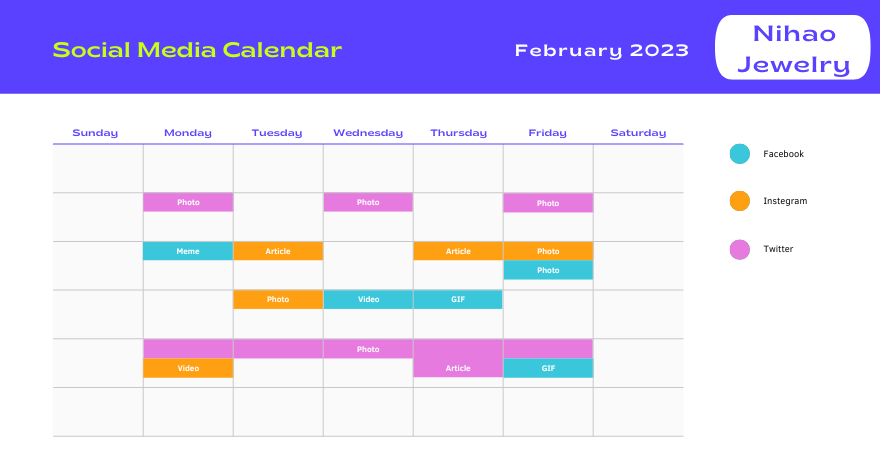In today’s digital age, social media has become an essential tool for businesses to reach and engage with their target audience. However, with so many social media platforms available and the ever-increasing demands for quality content, it can be challenging to manage your social media presence effectively. This is where a social media calendar can help.
A social media calendar is a tool that allows you to plan your content ahead of time, ensuring that your social media accounts remain active, engaging, and aligned with your overall marketing strategy. In this article, we will guide you through the process of creating a social media calendar to plan your content effectively.

Determine Your Goals
The first step in creating a social media calendar is to define your social media goals. What do you want to achieve through your social media presence? Do you want to increase brand awareness, generate leads, or drive sales? Your social media goals should be specific, measurable, attainable, relevant, and time-bound (SMART). Your goals could include increasing your brand awareness, driving traffic to your website, generating leads, boosting sales, or engaging with your audience.
Once you have defined your social media goals, you can align your content with those goals. For example, if your goal is to generate leads, you may want to create content that educates your audience on the benefits of your product or service and encourage them to take action.

Identify Your Target Audience
The next step is to identify your target audience. Who are your ideal customers, and what are their interests, needs, and pain points? Understanding your target audience’s preferences and behaviors can help you create content that resonates with them and increases engagement.
There are various ways to research your target audience, including social media analytics, customer surveys, and competitor analysis. You can also create buyer personas, which are fictional representations of your ideal customers that help you understand their demographics, behavior, and goals.
Choose Your Social Media Channels
There are a wide variety of social media platforms available, each with its own strengths and weaknesses. In order to effectively use social media to promote your business, you need to choose the platforms that are most relevant to your target audience. Some of the most popular social media platforms include:
To choose the right social media channels, you need to consider your audience’s demographics, interests, and behavior. For example, if your target audience is primarily professionals, LinkedIn may be the best platform to engage with them. Similarly, if your target audience is visually oriented, Instagram or Pinterest may be a better choice.
Choose Content Themes
The next step in creating a social media calendar is to determine the themes or topics you want to cover in your content, based on your brand and audience. Your content themes should be relevant to your target audience’s interests, needs, and pain points, and aligned with your overall marketing strategy.
There are various content themes you can choose from, including educational, promotional, inspirational, and entertaining. You can also leverage current events or industry trends to create timely and relevant content that resonates with your audience.
Create a Content Mix
Once you have determined your content themes, the next step is to choose the types of content you want to publish. There are many types of content you can create, including blog posts, videos, images, infographics, podcasts, and webinars. Your content mix should be diverse and engaging, catering to different types of learners and preferences.
When choosing your content mix, you should consider the format, length, and style of your content. For example, short-form videos may be more effective on Instagram, while long-form blog posts may be more effective on LinkedIn. You should also consider your audience’s preferences and behavior, such as when they are most active on social media.
Plan Your Content Calendar

Once you have your goals, target audience, social media channels, content themes, and content types, it’s time to create your social media calendar. Your social media calendar should include the following elements:
Posting frequency: Decide how often you want to post on each social media platform. Posting frequency should be consistent and optimized for each platform.
Posting times: Determine the best times to post on each platform based on your audience’s time zone, behavior, and engagement patterns.
Content themes: Assign a content theme to each social media post to ensure consistency and relevance.
Content types: Assign a content type to each social media post, such as a blog post, video, or image.
Call to action: Include a call to action in each social media post to encourage engagement, such as likes, comments, shares, or website visits.
Create and Publish Your Content
Once you have planned your content calendar, it’s time to create and publish your content. Make sure your content aligns with your brand and your audience’s preferences. Also, ensure that your content is of high quality and adds value to your audience.
Here are some tips to help you create content for social media posts:
Choose the right format: There are many types of content that you can create for social media, including images, videos, infographics, GIFs, and more. Choose the right format based on your goals and your audience’s preferences.
Keep it visual: People are more likely to engage with visual content. Use high-quality images, videos, and graphics to grab their attention.
Tell a story: Stories are a powerful way to connect with your audience. Use storytelling techniques to create content that’s relatable and memorable.
Be consistent: Consistency is key when it comes to social media. Your content should have a consistent tone, style, and message.
Keep it concise: Social media users have short attention spans. Keep your content concise and to the point.
Use hashtags: Hashtags are a great way to increase your reach and connect with new followers. Use relevant hashtags in your posts to make them more discoverable.
Include a call to action: Every social media post should have a clear call to action. Encourage your audience to take action, whether it’s to visit your website, sign up for your newsletter, or make a purchase.
Monitor and Evaluate Your Social Media Content
After publishing your content, you need to monitor its performance and evaluate its effectiveness. Use analytics tools to measure your social media metrics, such as reach, engagement, clicks, and conversions. Use the insights gained to adjust your social media strategy to improve your content’s performance.

In conclusion, a social media calendar is an essential tool for planning and executing your social media strategy. With the above steps, you can create a social media calendar that will help you consistently publish high-quality content.
Don’t miss out on our latest tips and tricks for social media success! Follow the Nihaojewelry blog to stay up-to-date on the latest trends and strategies in digital marketing. Sign up now and take your social media game to the next level!






One Comment
Abdul
Great blog . keep up the great work.